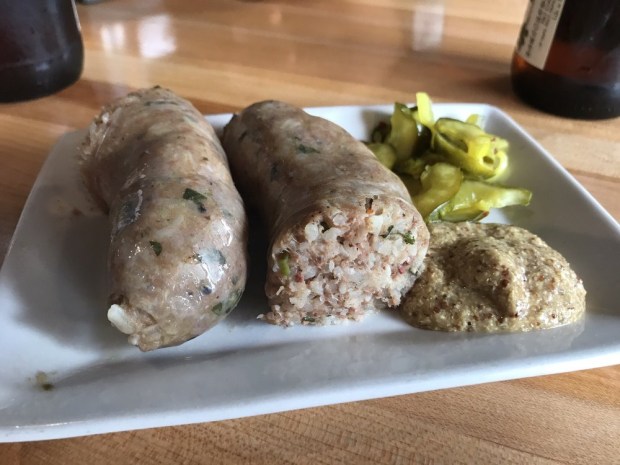Boudin, the king of Cajun food, is my favorite thing in the world to eat. It is a unique food in that it can be breakfast, lunch, dinner, a snack, or car food. Whereas most of the country might show up at a morning get-together with donuts, we show up with boudin. And no two boudins are exactly alike—that’s amazing, considering they all have basically the same ingredients of rice and pork.
One of the best boudins I’ve had is made by my cousin Bubba Frey, who owns the Mowata General Store in the heart of the German settlement between the Link and Zaunbrecher rice fields, but all my cousins down there make their own boudin. One cousin told me that meat from the temple of the pig’s head makes the best boudin, while another claims that a combination of hog jowl and shoulder meat is the secret. The truth is, they are all good.
This recipe combines elements from all of the different boudins I’ve eaten in my day. There’s liver in it but just enough, it’s nicely spiced but won’t burn your mouth, and it has the perfect amount of rice.

Ingredients:
(Makes 4 pounds)
2 pounds boneless pork shoulder, cut into 1-inch cubes
½ pound pork liver, cut into 1-inch cubes
1 small onion, chopped
2 celery stalks, chopped
1 medium poblano chile, stemmed, seeded, and chopped
3 medium jalapeño peppers, stemmed, seeded, and chopped
6 garlic cloves, coarsely chopped
4 tablespoons kosher salt
1 tablespoon ground black pepper
1 tablespoon ground white pepper
½ teaspoon curing salt (see Sidebar, page 21)
1 teaspoon cayenne pepper
1 teaspoon chili powder
7 cups cooked white rice
1 cup chopped fresh parsley
1 cup chopped scallions (green and white parts)
4 to 6 feet of sausage casings (optional), rinsed
Preparation:
Combine the pork, liver, vegetables, and seasonings in a bowl and marinate for 1 hour or overnight, covered, in the refrigerator. Place the marinated mixture in a large pot and cover the meat with water (by 1 to 2 inches). Bring the mixture to a boil, reduce the heat, and simmer until the meat is tender, about 1 hour and 45 minutes.
Remove the pot from the heat and strain, reserving the liquid. Allow the mixture to cool slightly, then put the solids through a meat grinder set on coarse grind. (You can also chop with a knife if you don’t have a meat grinder, which is what I usually do anyway.)
Place the ground meat in a large bowl. Using a wooden spoon or rubber spatula, mix in the cooked rice, parsley, scallions, and the reserved cooking liquid. Stir vigorously for 5 minutes. When the boudin-rice mixture is first combined, it looks very wet and it’s pretty spicy. Don’t worry; after poaching, the rice absorbs the excess moisture and much of the spice. The wet texture and extra spice ensure that your final boudin will be moist and full of flavor.
At this point you can feed the sausage into the casings (see Sidebar, page 28). Poach the links gently in hot (not bubbling) water for about 10 minutes, then serve. Alternatively, you can use the mixture as a stuffing for chicken, or roll it into “boudin balls,” dredge in bread crumbs, and fry in hot oil until golden brown.
NOTE: To eat fresh, hot poached boudin, bite into the link and use your teeth and fingers to gently pull the meat out of its soft casing. (The casings are only eaten when the boudin is grilled or smoked and they become crisp.) You can also slice the boudin and tease the meat out with a fork, though utensils are not encouraged.
Some locals eat boudin with a dab of Creole mustard, a drizzle of cane syrup, a French roll, or a few crackers. But most feel that it, like a few of life’s other illicit pleasures, is best enjoyed in the heat of the moment, eaten straight from the wrapper, while sitting in one’s car. This is not a region known for its pretension: It is fondly said that a Cajun seven-course meal is a pound of boudin and a six-pack of beer.
Reprinted from Real Cajun: Rustic Home Cooking from Donald Link’s Louisiana. Copyright © 2009 by Donald Link. Photographs © 2009 by Chris Granger. Published by Clarkson Potter/Publishers, an imprint of Penguin Random House, LLC.